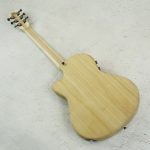- Ilaria Fantin
- Daniele Camarda
- Michael League
To paulownia or not to paulownia?
I took inspiration from a discussion of guitar Youtubers, trying to “counterinform”, not for the spirit of counterpoint but rather to offer the point of view of a “heretical” guitar builder.
I learned from youtubers their consensus that paulownia is a “crap wood”.
Wood is wood, it is a plant that grows, with the most varied range of characteristics based on the essence of each species. It is neither gold, nor lithium, nor oil. It is a raw material with a value derived from the processing costs, but above all subject from the laws of the market.
“I have seen broken paulownia guitars..” I, too, have seen a broken Gbsn SG, thanks to an inopportune highly fragile neck-body joint. Not to mention the headstock of the same instrument. And not of the low-priced series.
It all depends on how the instrument is built. The stress points. If the wood is light, it must be reinforced and sized using proper criteria.
If the reduced weight and the tonal response offered by the paulownia are the elements desired by the customer, with the right design attention, it can be an excellent choice.
I have used paulownia with excellent results to build both basses and guitars, especially for semi-acoustic instruments. In solid-bodies, it would make Nile Roger happy.
“Paulownia is a wood that the furniture builders in the East have often used.”
In 2005 I discovered that the importer from Africa of Terminalia Superba, called Liba or Frakè, wood that is intended for the construction of coffins (again in the East) was actually Corina, a mythological wood for guitarists, which for decades had disappeared from the music scene.
I started using Corina because it was inexpensive, but aesthetically very nice, and the same order could include both heavy wood with a bright sound, and lighter wood with a soft sound, offering many tonal variations.
Over the years, from the huge railway yards full of stacks of Limba (Corina) at an affordable price, we now have developed a scarcity, because even large guitar producers have now begun to use it. The price has now soared.
Beginning in 2012, I started using chestnut, plane tree, paulownia, beech, maple, walnut, all local or in any case Italian. Here in Italy, there is more choice, more variety, there is a relationship with those who cut, saw and season them. I’ve always bought wood from local sawmills, to have a good choice, make the selection myself, and keep costs down. And above all, I always find what I need.
In the construction of an instrument, what counts is always the sought-after characteristics, the technical solutions, the correct use made of a certain component. The choice of wood in musical instruments is highly subject to trends related to commercial production practices. Already in the 90s I published an editorial in which, at a time when to be “cool” one had to choose only woods used by the Americans, I reiterated that Stradivari really had to be an idiot to use Italian woods!
Thanks to Richard Davidow for the editing.


















 Italiano
Italiano











